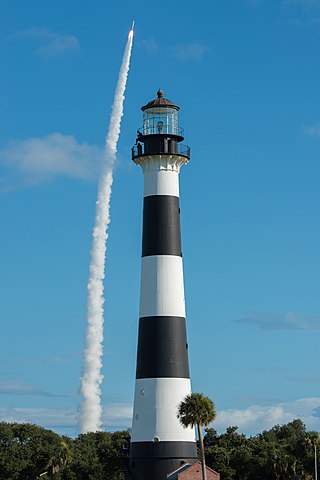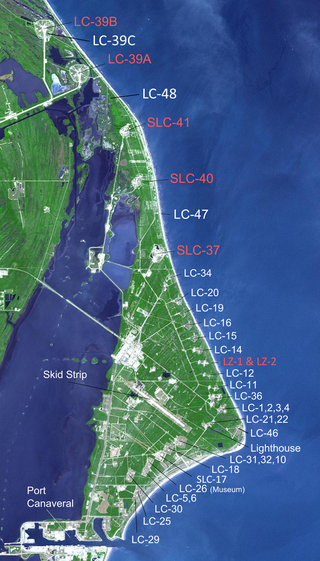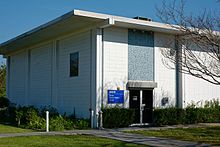
The John F. Kennedy Space Center, located on Merritt Island, Florida, is one of the National Aeronautics and Space Administration's (NASA) ten field centers. Since December 1968, KSC has been NASA's primary launch center of human spaceflight. Launch operations for the Apollo, Skylab and Space Shuttle programs were carried out from Kennedy Space Center Launch Complex 39 and managed by KSC. Located on the east coast of Florida, KSC is adjacent to Cape Canaveral Space Force Station (CCSFS). The management of the two entities work very closely together, share resources and operate facilities on each other's property.

Cape Canaveral Space Force Station (CCSFS) is an installation of the United States Space Force's Space Launch Delta 45, located on Cape Canaveral in Brevard County, Florida.

Gemini 2 was the second spaceflight of the American human spaceflight program Project Gemini, and was launched and recovered on January 19, 1965. Gemini 2, like Gemini 1, was an uncrewed mission intended as a test flight of the Gemini spacecraft. Unlike Gemini 1, which was placed into orbit, Gemini 2 made a suborbital flight, primarily intended to test the spacecraft's heat shield. It was launched on a Titan II GLV rocket. The spacecraft used for the Gemini 2 mission was later refurbished into the Gemini B configuration, and was subsequently launched on another suborbital flight, along with OPS 0855, as a test for the US Air Force Manned Orbital Laboratory. Gemini spacecraft no. 2 was the first craft to make more than one spaceflight since the X-15, and the only one until Space Shuttle Columbia flew its second mission in 1981; it would also be the only space capsule to be reused until Crew Dragon Endeavour was launched a second time in 2021.

The Cape Canaveral Light is a historic lighthouse on the east coast of the U.S. state of Florida. The light was established in 1848 to warn ships of the dangerous shoals that lie off its coast. It is located inside the Cape Canaveral Space Force Station and managed by the Space Launch Delta 45 of the U.S. Space Force with the assistance of the Cape Canaveral Lighthouse Foundation. It is the only fully operational lighthouse owned by the United States Space Force.

A rocket garden is a display of missiles, sounding rockets, or space launch vehicles, usually in an outdoor setting. The proper form of the term usually refers to the Rocket Garden at the Kennedy Space Center Visitor Complex.

Launch Complex 34 (LC-34) is a deactivated launch site on Cape Canaveral Space Force Station, Florida. LC-34 and its companion LC-37 to the north were used by NASA from 1961 through 1968 to launch Saturn I and IB rockets as part of the Apollo program. It was the site of the Apollo 1 fire, which claimed the lives of astronauts Gus Grissom, Ed White, and Roger Chaffee on January 27, 1967. The first crewed Apollo launch — Apollo 7 on October 11, 1968 — was the last time LC-34 was used.

Launch Complex 19 (LC-19) is a deactivated launch site on Cape Canaveral Space Force Station, Florida used by NASA to launch all of the Gemini crewed spaceflights. It was also used by uncrewed Titan I and Titan II missiles.

Cape Canaveral Launch Complex 5 (LC-5) was a launch site at Cape Canaveral Space Force Station, Florida used for various Redstone and Jupiter launches.

Launch Complex 36 (LC-36)—formerly known as Space Launch Complex 36 (SLC-36) from 1997 to 2010—is a launch complex at Cape Canaveral Space Force Station in Brevard County, Florida. It was used for Atlas launches by NASA and the U.S. Air Force from 1962 until 2005.

Launch Complex 26 (LC-26) is a deactivated launch site at Cape Canaveral Space Force Station, Florida. LC-26 consisted of two pads, A and B. Pad A was used for the Jupiter-C and Juno I rockets, and was the launch site for Explorer 1, the United States' first satellite, in 1958. Pad B was used for Juno II. Jupiter IRBMs were launched from both pads.
Space Launch Complex 20 (SLC-20), previously designated Launch Complex 20 (LC-20), is a launch site at Cape Canaveral Space Force Station, Florida. SLC-20 is located at the northern terminus of ICBM Road, between Space Launch Complex 19 and Space Launch Complex 34.

Launch Complex 3 (LC-3) is a deactivated launch site southeast of SLC-36 on Cape Canaveral, Florida at Cape Canaveral Space Force Station. It was constructed, with launch complexes 1, 2, and 4, in the early 1950s for the Snark missile program.
Launch Complex 4 (LC-4) was one of the first series of launch complexes to be built at Cape Canaveral Space Force Station on Cape Canaveral, Florida. It consisted of two pads, LC-4 which was used for 25 launches of Bomarc, Matador and Redstone missiles between 1952 and 1960; and LC-4A, which was used for three Bomarc launches between 1958 and 1959.
Launch Complex 6 (LC-6) at Cape Canaveral Space Force Station, Florida is a launch site used by Redstone and Jupiter series rockets and missiles. It is on the south end of Cape Canaveral, close to Launch Complex 5, with which it shared a blockhouse. With LC-5, it was the location of the first tests of the mobile launch concept designed by Kurt H. Debus. This concept was revised and improved and eventually used at LC-39 for the Saturn V and Space Shuttle.

Launch Complex 13 (LC-13) was a launch complex at Cape Canaveral Space Force Station, the third-most southerly of the original launch complexes known as Missile Row, lying between LC-12 and LC-14. In 2015, the LC-13 site was leased by SpaceX and was renovated for use as Landing Zone 1 and Landing Zone 2, the company's East Coast landing location for returning Falcon 9 and Falcon Heavy launch vehicle booster stages. It is leased by US Space Force to Phantom Space and Vaya Space who will operate this launch complex after the termination of SpaceX's lease in future.

The Space Launch Complex 46 (SLC-46), previously Launch Complex 46 (LC-46), is a launch complex at Cape Canaveral Space Force Station operated under license by Space Florida previously used for Athena rocket launches.

Launch Complex 31 (LC-31) is a former launch complex at Cape Canaveral Space Force Station, Florida.
There are a number of Pershing missile displays of inert missiles in the U.S, Germany and Russia. The Pershing systems were eliminated after the ratification of the Intermediate-Range Nuclear Forces Treaty on 27 May 1988. The treaty allowed for a total of fifteen Pershing II and GLCM missiles for display and seven Pershing IIs were retained. A number of Pershing 1 and Pershing 1a missiles are also on display.

Cape Canaveral Launch Complex 47 is a launch pad for sounding rockets located at the north end of Cape Canaveral Space Force Station, Florida. It is the smallest launch complex at the Space Force Station. The complex features a small blockhouse a few yards from the pad, containing vehicle-specific hardware. Between 1984 and 2008, 531 sounding rockets were launched from pad 47. All weather rocket operations were relocated here from Launch Complex 43 in 1984 in order to make room for the construction of Launch Complex 46.

























